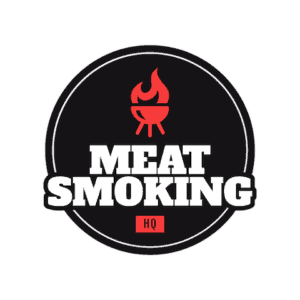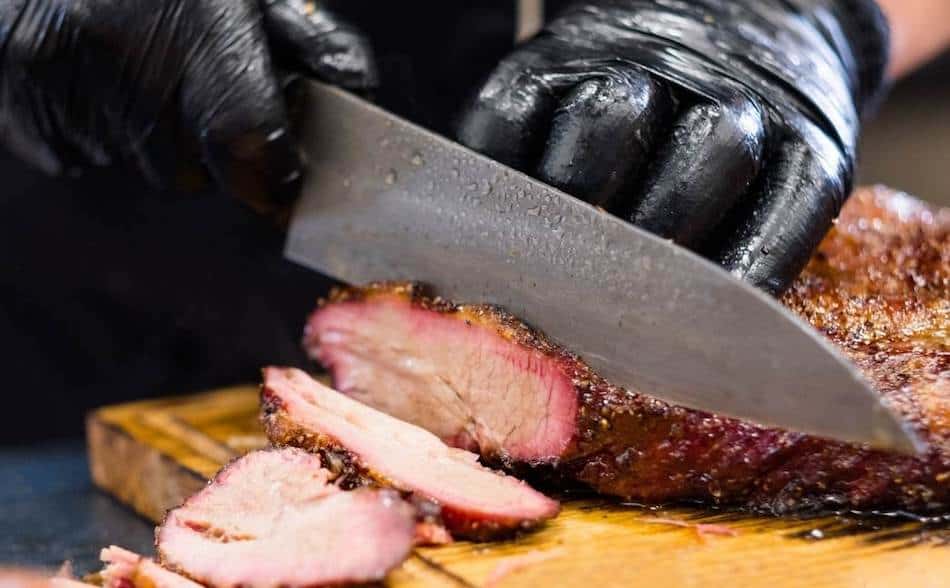
The brisket is the pinnacle of meat smoking and the ultimate cut of meat to master in your pit. The brisket is also the most difficult cut of meat to smoke because it’s such a large, tough hunk of meat that requires all day and half the night to cook. There’s nothing worse than smoking a brisket for 12 hours, only to have it turn out dry. There’s are a few things you can do to make sure you get a tender, juicy brisket every time.
1. Keep The Temperature Between 225°F and 250°F
Brisket is a large, tough cut of meat and should be smoked low and slow at 225°F (107°C). Temperature control will make or break your brisket, but if you’re using a pellet grill an electric or gas smoker, maintaining the target temperature is easy. Holding the temp at the required 225°F can be a challenge when smoking a brisket in a charcoal smoker.
If you’re just starting out, don’t attempt smoking a brisket until you have mastered temperature control in your pit. Once you know your smoker and can control temperature fluctuations, only then should you smoke a brisket. Work your way up to a brisket by smoking a pork butt. Pork butts are a great introduction to the big meats because they’re hard to mess up.
Vent Control. Learning how to control your smoker is the first rule of meat smoking. Temperature control is easy if you are smoking on a pellet grill or an electric smoker, but charcoal smokers can be difficult to control a steady temperature. Know how to control your vents so you can hold the temperature in a safe range. Also, keep your smoker out of the wind and don’t keep opening the lid of your smoker. These mistakes will cause the temperature to fluctuate, and ruin your brisket.
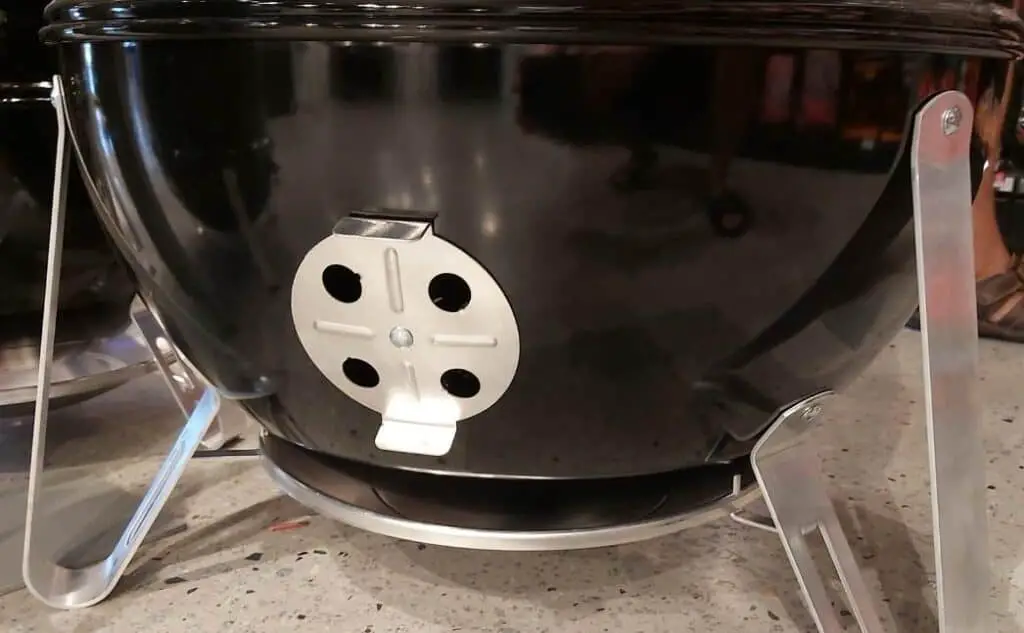
Low and Slow. Brisket is a tough cut of meat with a lot of connective tissue, so it needs to be cooked low and slow. If the temperature of your smoker is too high, the heat will draw out the moisture in the brisket and it will become dry. Learn to hold the temperature of your smoker in the 220°F range and keep it there until the internal meat temperature reads 203°F on your meat thermometer.
Meat Thermometers. No matter what type of smoker you’re using, a good thermometer will be your best friend. DO NOT trust the in-built thermometer that comes with your smoker because they can be wildly inaccurate. If you don’t believe me, do a calibration test.
Get yourself a good duel-probe thermometer that will allow you to monitor the ambient temperature of the cook chamber with the first probe and track the internal meat temperature with the second probe. A thermometer is by far your most important tool. Without one, it’s all guesswork. Check out my thermometer guide here.
2. Spritz Or Mop The Brisket
Adding moisture to your brisket by either basting, mopping or spritzing is an important practice when smoking brisket. Applying moisture to the brisket will do several things:
- It will make the brisket more tender by slowing down the cooking
- Help produce a better smoke ring
- Extra liquid will attract more smoke
- Aids in browning
- May help caramelize the bark
- Prevents meat from drying out
You can mop/spritz your brisket with apple cider vinegar, apple juice, bone broth, beer or plain water. Apply the liquid by using a spray bottle or a miniature mop and bucket. Don’t mop or spritz for the first 3 or 4 hours of the cook. During the first phase, allow the brisket to absorb smoke and develop a hard bark. If you spritz too soon, the rub will wash off the brisket and leave patches in the bark. After a few hours, begin wetting the meat every hour until the brisket reaches the wrapping stage. Spray underneath and on the sides where the brisket is at risk of charring or drying out. For more information on basting brisket, check out these articles: Basting Brisket While Smoking and How To Spritz Brisket.
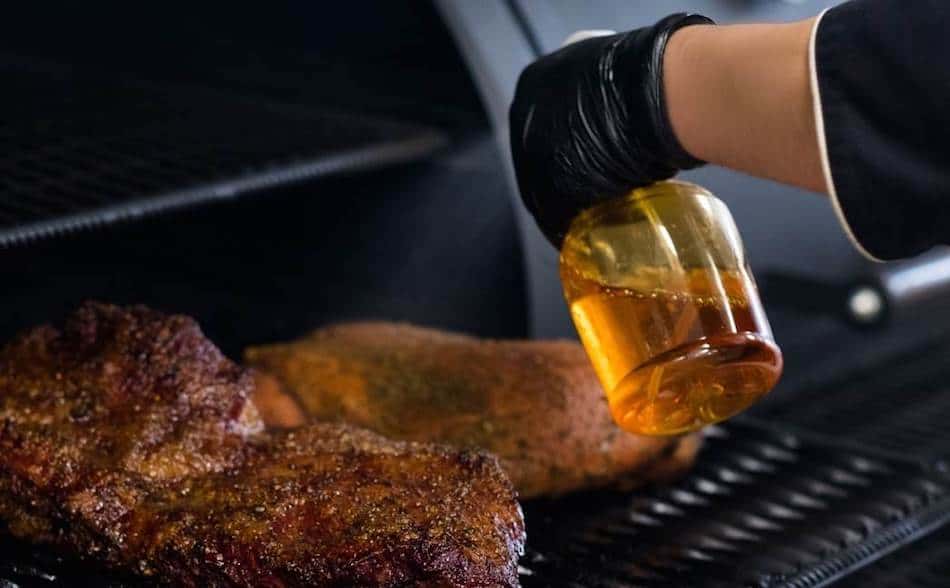
3. Buy The Right Brisket
Buying the right brisket is probably the most important step that often gets overlooked. You could do everything else right, but if you buy a lean brisket, it’s going to turn out dry. Learn how to choose a good brisket and always buy the best meat you can afford. There are three main beef grades in America:
- USDA Select
- USDA Choice
- USDA Prime
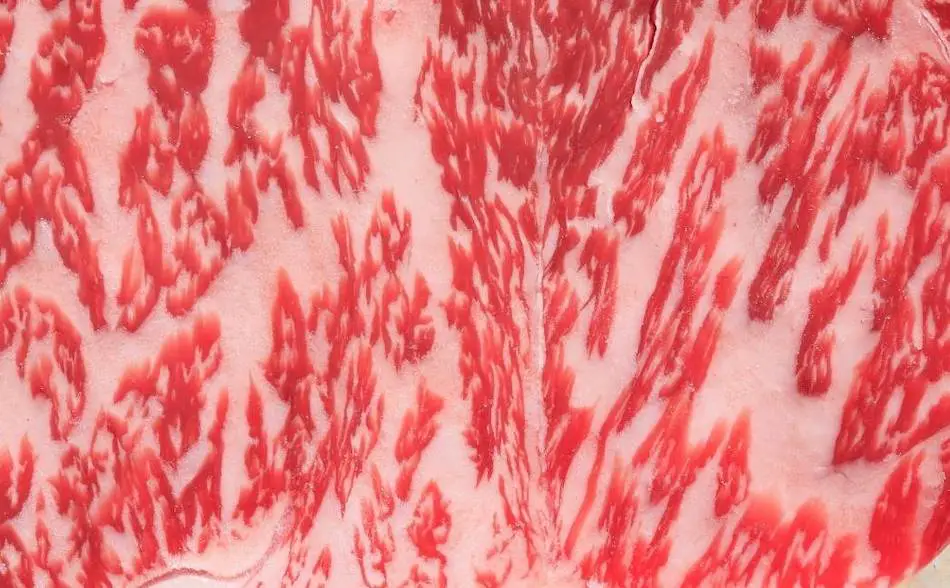
Marbling. A decent amount of marbling is the key to the most tender, juicy brisket. The more marbling the better. Marbling is the fatty striations that are found in meat. When cooked low-and-slow, marbling will melt and render into the meat, making it taste tender, juicy and full of flavor. The more marbling, the more expensive. Wagyu, USDA Prime, and USDA Choice have different levels of marbling, whereas USDA Select has little to no marbling at all. You can smoke a Select grade brisket, but you need to pull out all the tricks in the book to get good results. For more information, check out these articles:
What Brisket Should I Buy? Prime, Select or Prime
Wagyu: The World’s Best Brisket
Brisket Anatomy. Before visiting your butcher, it also pays to understand some brisket anatomy. Briskets have two parts; a flat and a point. Whole packer briskets are the most commonly sought after briskets for smoking, but you can buy a flat or a point separately. The point is easier to cook, and contains more fat which means it’s less likely to dry out. The flat is more difficult to manage because it has little fat, and it’s a thin, awkward-shaped muscle. Some pitmasters remove the point and the flat and cook them separately. If you want to know how to cook a brisket flat, check out this article: How To Smoke A Brisket Flat.
The Fat Cap. Choosing a brisket with the right amount of fat is also important. Avoid briskets with thick fat cap because most of it needs to be trimmed so you will be wasting your money. However, you need some fat otherwise the brisket will dry out and have less flavor. Most pitmasters recommend leaving 1/4 inch of fat on top.
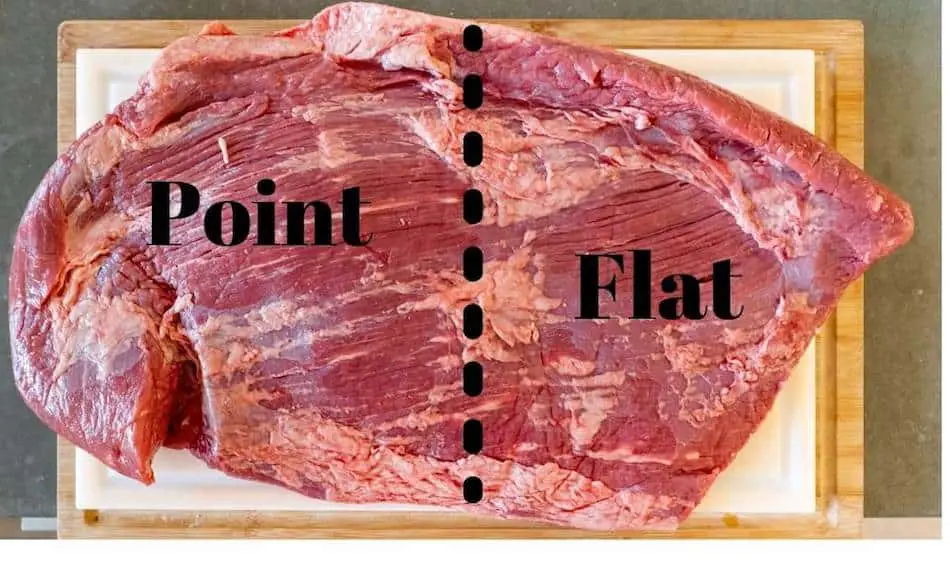
4. Brine The Brisket
Dry Brining. Brining your brisket prior to smoking is a good way to help retain the moisture during the long cook. Dry brining is the most simple, and best way to brine a brisket. Soaking brisket in a wet brine isn’t suitable because the meat will end up like tasting like corned beef. A dry brine is simply rubbing salt into the brisket the day before smoking. The salt will penetrate the meat retain moisture during the long cook. Salt will also add flavor.
The Best Salt For Brining Brisket. Kosher salt is the best salt to brine brisket because it has large granules, anti-caking agents and no iodine. Once you’ve rubbed salt into the brisket, place the meat in a large zip-lock bag and leave in the refrigerator for 24 hours before smoking. The bare minimum time to dry brine a brisket is 2-hours prior to smoking. For more on brining, read: Should I Brine Brisket?
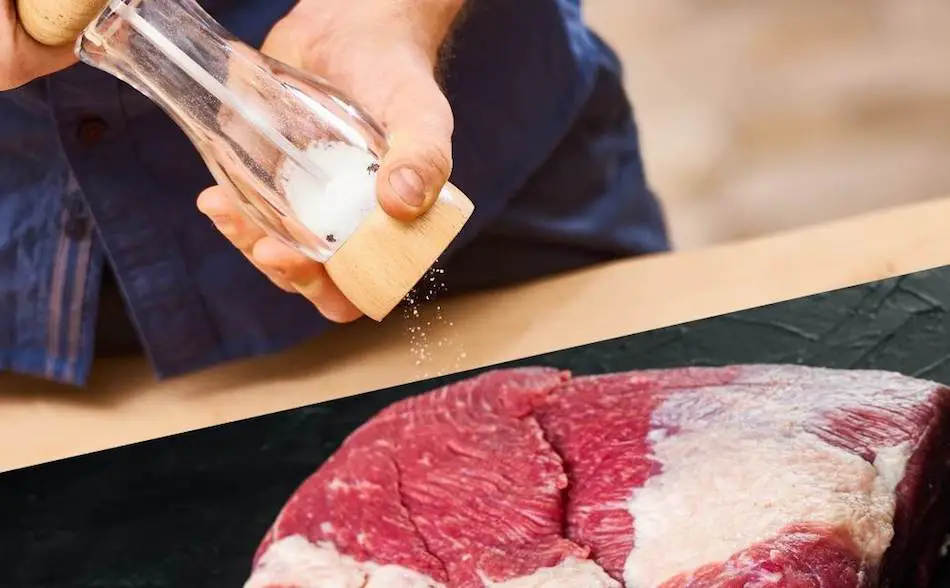
5. Inject The Brisket
Injecting brisket is also a good way to get extra moisture deep inside the meat for the long cook. Brisket will lose a lot of moisture, so having more fluid in the meat will help replace the moisture that is lost through evaporation. Competition meat smokers inject brisket for extra flavor and helping to get a tender, juicy brisket.
Brisket Solutions and Marinades. The best injection fluid is bone broth or a good brisket marinade. Meat injectors are simple to use, inexpensive and easy to buy on Amazon or the barbecue section of your hardware store. It’s best to inject the brisket the day before to allow the marinade to work its way into the meat. For an in-depth look at brisket injection, check out my article: Should I Inject Brisket?
This brisket injection marinade is the secret used in competitions and made by a World Barbecue champion.
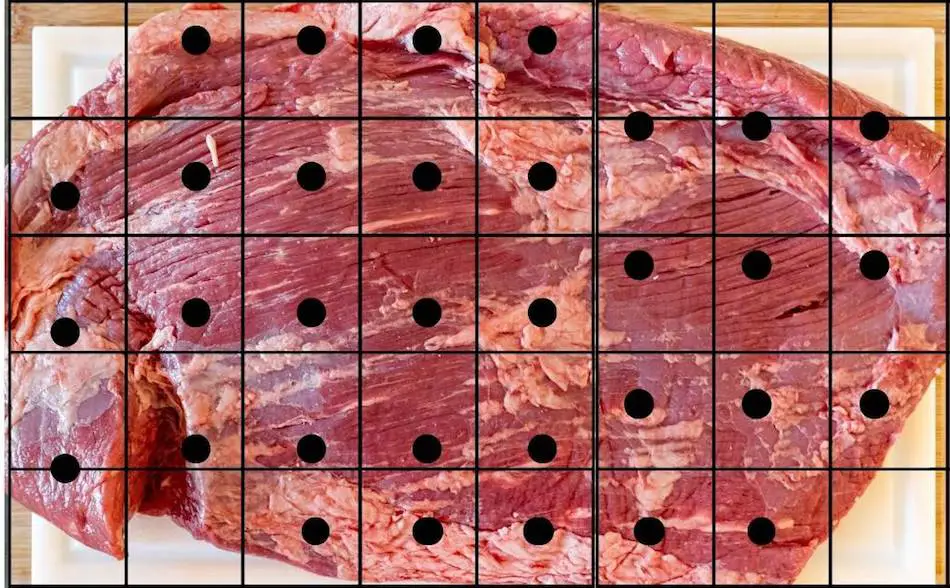
6. Rest The Brisket
The resting or holding stage is one of the most important steps in the brisket smoking process. If you slice the meat immediately after taking the brisket out of the smoker, all the meat juices will spill out onto the cutting board and the meat will be dry. Resting allows the meat to reabsorb its juices and makes the brisket tender and juicy.
How Long To Rest Brisket. A brisket can be rested for as long as 4-hours but a minimum of 1-hour. While resting, the meat will continue to cook and will still be hot after 4 hours.
Resting Brisket In A Cooler. The most common way to rest a brisket is by wrapping the foiled brisket in a towel and then placed in a dry cooler for between 1-4 hours. Keep the meat in its foil wrapping, otherwise the juices will spill out. For more on resting/holding, check out these articles: How Long Should I Rest Brisket? and Resting Brisket in a Cooler.
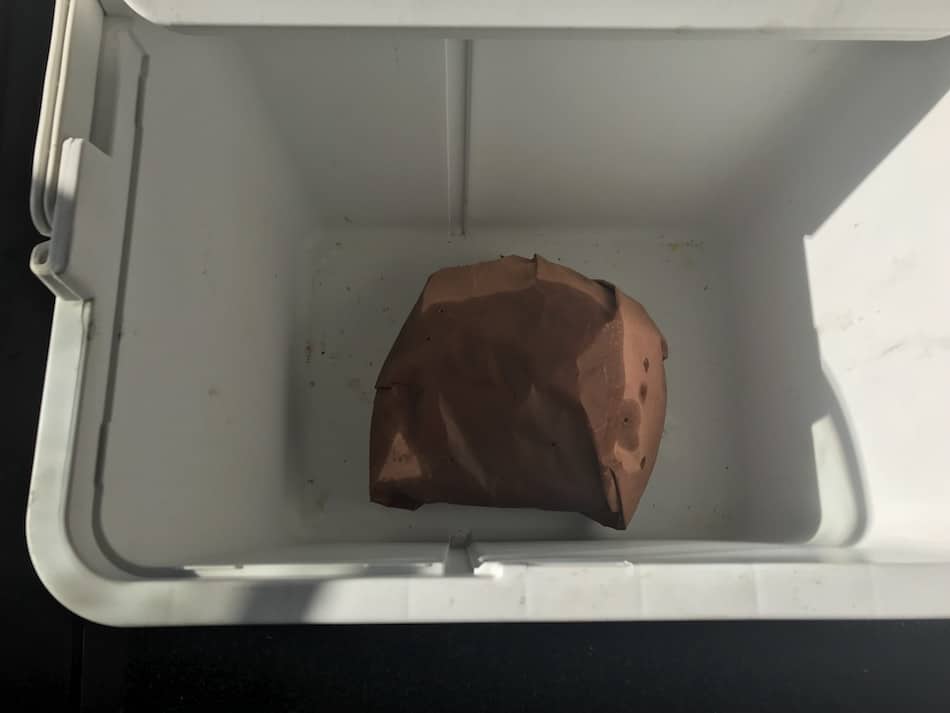
7. Wrap The Brisket
Wrapping brisket in foil or butcher paper is an important step in the smoking process if you want tender, juicy meat. Wrapping the brisket in the second half of the cook will prevent moisture from escaping and will create steam inside the meat parcel. Wrap your brisket when the internal meat temperature reaches anywhere between 150°F and 170°F, which is usually around 8-10 hours into the cook, depending on the size of the brisket. If you wrap within the 150°F and 170°F range, the brisket should have developed a nice bark, be a reddish color and taken on more than enough smoke.
Paper or Foil? You can use aluminium foil or butcher paper to wrap brisket, but if this is your first attempt, keep it simple and use foil. The paper vs foil is one of the most asked questions in barbecue. If you’re smoking your first brisket, it’s okay to just use heavy duty aluminium foil. Then once you know what you’re doing, experiment with butcher paper. Aaron Franklin popularized pink butcher paper and his experiments show you get a better bark. Others say the differences are minimal. The only way to know is to try them yourself. If you’re going to try butcher paper, you need to buy a specific kind. You can’t just use any old butcher paper because they may contain harmful chemicals. Amazon sells large rolls of the correct type of butcher paper here. For more information wrapping brisket, read my article: ‘What Should I Wrap My Brisket In?
8. Cook Brisket To 203°F
The key to low-and-slow cooking is to cook to temperature, not time. The magic number with brisket is a 203°F internal meat temperature. The meat needs to reach an internal temp of about 200°F for the meat to be tender and juicy. Technically, the meat is considered done at a 160°F internal, but brisket is a tough cut of meat with a lot of connective tissue and all the fat and gristle won’t have rendered and will be chewy if it’s pulled from the smoker at 160°F internal. A 203°F brisket will allow the connective tissue to melt and form the gelatin texture that makes smoked brisket famous. Rest the brisket for at least 1-hour before slicing, but 4-hours rest is ideal.
9. Don’t Trust The In-Built Thermometer
A decent meat thermometer will be your best friend when smoking a brisket. Without a thermometer, you will be operating in the dark. Tracking the ambient temperature of the smoker and tracking the internal meat temperature is the key to smoking a tender, juicy brisket.
There are dozens of thermometers on the market from the basic $50 duel-probe thermometers up to the fancy 8 probe wi-fi thermometers that cost hundreds of dollars. It’s important not to buy a cheap thermometer because they can give inaccurate readings, which defeats the purpose of using a thermometer.
ThermoWorks and ThermoPro are two trusted companies that are well known in the barbecue and cooking industry. For more information on thermometers, check out some of my thermometer guides: The Beginner’s Guide to Meat Thermometers, The Best Meat Thermometers Under $50, The Best Thermometers for Smoking Meat
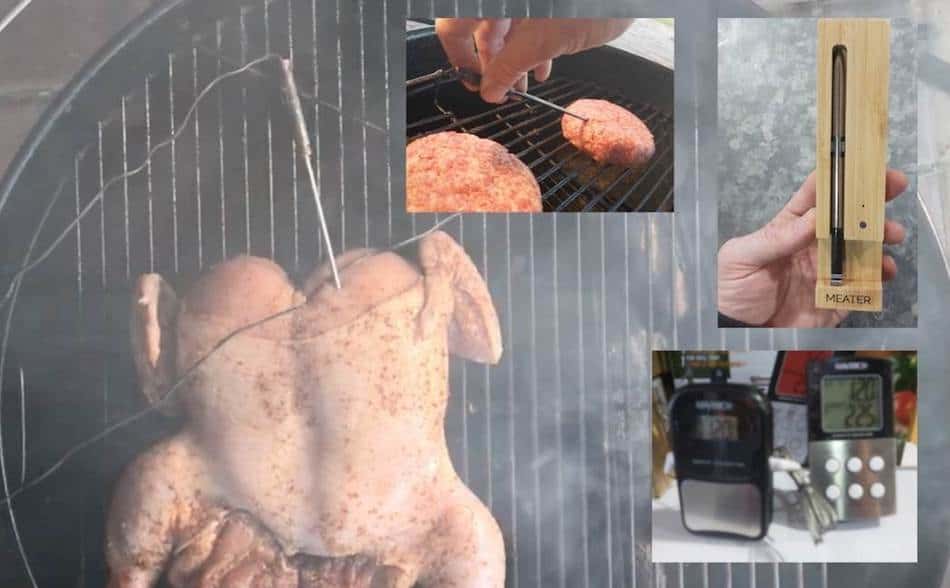
10. Use Hickory, Oak, Mesquite or Pecan
The best wood for smoking brisket is any of the woods that blend well with beef. Unlike other cuts of meat such as chicken or fish, brisket is a tough cut so it can handle any type of wood. The best wood for brisket are:
- Hickory
- Mesquite
- Oak
- Maple
- Alder
- Pecan
Hickory is the king of smoking woods, has a strong smoke flavor and blends well with brisket. Mesquite is a popular wood for brisket in Texas and Arizona, but mesquite can be too overbearing for most people. Oak is a safe choice for brisket, so is pecan, maple or alder. The type of wood you use will depend on your smoker. If you have a charcoal smoker, wood chunks work best and will need to be added to the fire every few hours. You won’t need to add wood after the brisket had been wrapped, because by that stage, the meat won’t take on any more smoke.
11. Develop A Crispy Bark
The crispy outer layer of the brisket is formed by the rub and the Maillard Reaction that occurs during the uncovered phase of the cook. The key to a good brisket bark is to know when to wrap the meat. If you wrap the brisket too early, the bark won’t be firm enough to survive all the added moisture when wrapped up.
A Naked Brisket. Wrapping is an important step in the brisket smoking process, but it softens the bark. The best way to get a firm brisket is to smoke it unwrapped. This is the traditional way of smoking brisket, but this method is a sure way to dry out the meat. Experiment by smoking a naked brisket at some stage, but in your first few attempts, I highly recommend wrapping.
Return To The Grill After Wrapping. A wrapped brisket will have a soggy bark, but if you place the brisket back on the grill for 10-minutes just before slicing, the bark should dry out and become crispy again. That way, you get a juicy brisket and a firm bark. A common way to deal with a softened bark is to cook the brisket uncovered until the internal meat temperature hits 150°F (which is usually 8-10 hours into the cook). By this stage, the brisket should have a hard bark and is ready for wrapping. Continue cooking the wrapped brisket until the meat hits a 203°F internal temperature, then remove from the smoker. Let the meat rest for at least 1 hour. Then, just before you slice the brisket, place the meat back onto the grill for a few minutes until the bark dries.
The Rub Forms The Bark. The rub plays an important role in bark formation, which is why using a binder for the rub is important. Mustard is the best binder and you won’t be able to taste it. Cover the meat in mustard, then apply a generous amount of beef rub to the brisket. For a more in-depth look at brisket bark, read my article: How to Get A Good Bark on a Brisket.
12. Make Your Own Rub
There are dozens of brisket rubs on the market and even more homemade recipes online. Some people overcomplicate rubs, but a simple beef rub works well with brisket. I like to control the salt content, so I make my own rub. Most pre-made rubs contain a lot of salt, so if you’re planning on brining your brisket, monitor the salt carefully. Also, be careful with sugary beef rubs because they can burn easily and turn your meat bitter and black. If you make a homemade rub, use turbinado sugar because it can withstand heat.
Homemade Rub. Making your own rub is easy and can be as simple as kosher salt and black pepper (which is Aaron Franklin’s brisket rub), but most brisket rub recipes are a combination of garlic powder, paprika, onion powder, black pepper, kosher salt, turbinado sugar and Montreal Steak Seasoning. Here is a great homemade rub recipe:
Standard Barbecue Rub

I found this great rub recipe through How To BBQ Right. I use this recipe and alter it slightly depending on what I'm cooking. Made by the guys at Townsend Spice & Supply: https://townsendspice.com/
Ingredients
- - ½ Cup Paprika
- - ½ Cup Salt
- - ½ Cup Sugar
- - ½ Cup Granulated Garlic
- - ¼ Cup Granulated Onion
- - ¼ Cup Chili
- - ¼ Cup Cumin
- - 2 Tablespoons Black Pepper
- - 2 Tablespoons Dry Mustard
- - 1 Tablespoon Cayenne Pepper
Instructions
- Combine all the spices together in a large mixing bowl
- Store rub in rub shakers
13. Buy A Championship Rub
Pre-Made Rubs. If you want to buy a rub, I would recommend Killer Hogs TX Brisket Rub made by barbecue legend, Malcolm Reed. Otherwise, here is a list of some of the most popular rubs on the market:
14. Get A Nice Smoke Ring
The pink ring around the outer layer of the brisket is a sign that it was smoked low and slow. Smoke ring development results from chemical reactions on the surface of the meat caused by smoke. The smoke ring adds no flavor to the meat, it’s purely an emblem.
The best way to get a nice smoke ring on your brisket is to use a charcoal smoker. The fuel source plays an important role, so does the temperature of the smoker and moisture. Keep the smoker at a stable temperature and mop/spritz the meat every hour. Use a water pan in the smoker to increase the humidity, which will help create a smoke ring. If a smoke ring is important to you, avoid using acidic marinades on your brisket, because this will affect the smoke ring formation. Another important thing to remember is to trim the fat off the top of the brisket. If there’s too much fat on the outer layer of the meat, the chemical reactions won’t be able to take place. For more information on smoke rings, read my article: How To Get The Best Smoke Ring
15. Use A Binder
An important step is applying a binder to the brisket prior to adding the rub. A binder, also known as a slather, will help you avoid a patchy bark by helping the rub stick to the brisket. A binder can be anything that will help your rub to stick to the meat and form a bark. Mustard is the most common binder, but you can use oil. I’ve written a detailed article on brisket binders, and you can read it here: Binder For Brisket: Should You Slather?
16. Use The Right Smoker
Not all smokers can smoke brisket because it’s a huge chunk of meat and a marathon cook. Brisket needs to be cooked in a smoker that can keep a steady temperature and retain heat. Cheap smokers have thin metal, so they struggle to keep the heat locked inside. Also, cheap smokers aren’t well sealed, so they leak a lot and cause massive temperature fluctuations. You can make modify cheap smokers by sealing the leaks and adding more insulation, but if you have the choice, buy a better smoker.
Pellet Smokers are the easiest of the ‘set-and-forget’ smokers and make the meat taste fantastic. Electric smokers are as easy to use as a conventional oven, but the brisket will taste nowhere near as good as other smokers.
Electric Smokers have their critics, but electrics are one of the easiest ways to smoke a brisket. Charcoal and wood smokers make smokier, more delicious briskets, but electric smokers allow you to smoke meat on days when you wouldn’t normally smoke meat. If your electric doesn’t give you a nice enough bark, finish the brisket at a high temperature in the oven. Also, if you want more smoke, insert a smoking tube into the smoker for more smoke flavor.
Charcoal Smokers add a distinct flavor to the meat, however, these smokers need to be well controlled to maintain steady temperatures. Charcoal smokers such as the Kamado Joe/Big Green Egg, Ugly Drum Smokers, and the Weber Smokey Mountain are the best of the charcoal smokers for smoking brisket. Weber kettles can smoke brisket, but they require a little more work. Offset smokers (stickburners) are the purest form of meat smoking and will produce the best brisket, however, they are by far the most difficult to manage. For more information, check out our Guide To Meat Smokers.
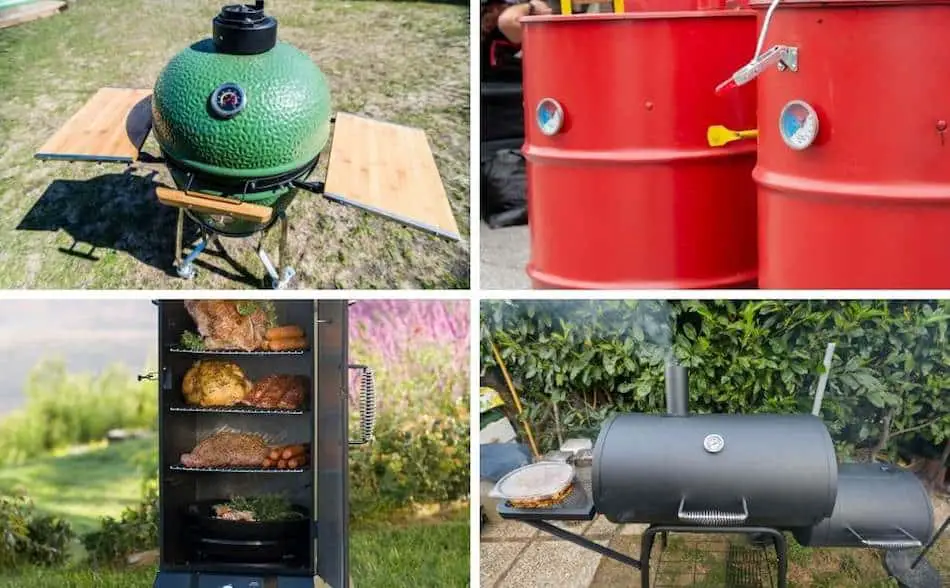
17. Learn To Deal With The Stall
The stall is an annoying thing all pitmasters have to contend with when smoking large cuts of meat. The stall is when the meat begins to sweat and cool down, which brings cooking to a halt for several hours. If you track the internal temperature of the brisket, it will climb steadily up to about 150°F and then stall. The meat can get stuck on 150°F for a few hours before crawling to the finishing line at a 203°F internal.
The best way to push through the stall is to wrap the brisket in aluminium foil or butcher paper. Wrapping will shave an hour or two off the cooking time and will make your brisket nice and juicy. A lot of people panic when the meat stalls, but it’s a normal part of the smoking process. You need to plan for the stall and allow plenty of time for the meat to reach its target temperature.
18. Marinade The Brisket For More Flavor
Marinade is a great way to get extra flavor deep inside the meat. You can search for brisket marinade recipes or you can use what the pros use in competitions. These marinades pre-made and ready to pump into your brisket. Not only will these marinades add flavor, they will also tenderize the meat. The Brisket Injection won first prize at the World Food Championship, as is used widely among competition smokers. The other popular brisket marinade is Fab B.
19. Clear The Calendar – Brisket Needs Time
Depending on the size, a brisket can take anywhere from 10 to 18 hours to cook—even longer. Keep in mind, that’s not including the resting period which can last up to 4-hours. Smoking a brisket is a marathon and you need to manage your time well. Some people wake up at all hours to attend to their brisket, but this means leaving your smoker unattended while you sleep (which carries some risks). Many people will nurture their brisket until foiling, then go to bed.
| Brisket Size | Temperature | Cook Time | Including Resting |
| 12 lbs | 225°F | 18 hours | 19 hours |
| 18 lbs | 250°F | 18 hours | 19 hours |
| 12 lbs unwrapped | 225°F | 19 hours | 20 hours |
| 18 lbs unwrapped | 250°F | 19 hours | 20 hours |
| 16 lbs | 275°F | 10 – 12 hours | 11-13 hours |
| 16 lbs unwrapped | 275°F | 11-13 hours | 12-14 hours |
Wrapping the brisket occurs when the meat hits about a 150°F internal, which is usually 8-10 hours into smoking. The first part of the cook is crucial for the development of the bark and absorbing smoke. This first phase of the cook requires adding wood to the smoker and mopping/spritzing every hour so the meat doesn’t dry out.
Once the meat is wrapped, the steam will keep the meat moist, so mopping isn’t required. Things slow down in the second half of the cook and not much happens. The brisket will hit the stall after as it crosses the 150°F internal meat temp, so that is a good time to go to bed. However, I don’t recommend leaving a smoker unattended because there is always the risk of a grease fire.
| Brisket Total Cook Time | Start Time | Begin Spritzing | Wrap Brisket | Finish in Oven | Done Time (203°F) | Holding Time In Dry Cooler (1-4 hours) |
| 12 hours | 6pm | 9pm | 12am | 12am | 6am | Between 7am – 10am |
| 15 hours | 5pm | 8pm | 11pm | 11pm | 8am | Between 9am – 12pm |
| 18 hours | 2pm | 5pm | 8pm | 8pm | 8am | Between 9am- 12pm |
20. Fat Side Up or Down? You Decide
Always place the fat side of the brisket towards the heat source. The fat will shield the meat from the heat and prevent it from drying out. So if the heat is underneath the grill, place the brisket fat cap down. Also, if the heat is coming from the side, place the point of the brisket towards the heat and the thinner flat away from the heat.
My Favorite Brisket Tools
Thanks for checking out this article. I hope you learned a few things. Here are some of my favorite tools I use when smoking brisket that may be useful to you. These are affiliate links, so if you decide to purchase any of these products, I’ll earn a commission. But in all honesty, these are the tools I recommend to my family and friends who are just starting out.
Meat Injector: Injecting meat is a great way to take your barbecue to the next level and help you make competition-style brisket. An injector is the only way you will be able to get flavor and moisture into the middle of the meat. The Beast Injector is a stainless steel injector that is sturdy and affordable. Check the latest price on Amazon here.
Brisket Marinade: The best injection solution on the market is the Butcher BBQ Brisket Injection. This marinade is used in competitions and is made by World Barbecue Champion pitmaster, Dave Bouska. You can find the marinade on Amazon here.
Butcher Paper: Wrapping brisket in butcher paper has become a huge trend in barbeque thanks to Aaron Franklin. Wrapping your brisket in paper will give you a nice brisket bark. However, you can’t just use any old paper, it has to be unwaxed, food grade paper. You can find it on Amazon here.
Brisket Rub: These days I make my own rub when possible, but I always have a few pre-made rubs for when I’m running low. Barbecue guru Malcom Reed produces Killer Hogs, one of the best brisket rubs I’ve found over the years. Another great rub is Slap Yo Daddy, made by brisket master and multiple World Barbecue Champion, Harry Soo.
Meat Thermometer: There are dozens of fancy thermometers on the market, but I still use my trusty TP20. For around $50, I have a high-quality meat thermometer with two probes, and can track the temperature of my smoker with one probe, and my meat with the other probe. The ThermoPro TP20 is an Amazon Best Seller because it’s the easiest thermometer to operate, is durable, highly accurate, and comes with pre-programmed meat settings.
Instant Read Thermometer: Arguably, the second most important tool you need is a fast and accurate instant-read thermometer. These tools play an important role in the latter stages of the cook when the meat needs regular checking in multiple areas. I use the ThermoPro TP19 because it can do everything a ThermaPen can do, but for a fraction of the cost. You can check out the TP19 on Amazon here.
Advanced Thermometer and Automatic Temperature Controller: Once you’re ready to take things seriously, the FireBoard 2 Drive is a six-channel Bluetooth/Wi-Fi thermometer that can monitor up to 6 pieces of meat, control and graph your cook sessions on your smartphone, and attaches to an an automatic blower that will convert your charcoal smoker to a set-and-forget. This is one of the most advanced meat thermometers on the market. You can check it out on the FireBoard website here.
